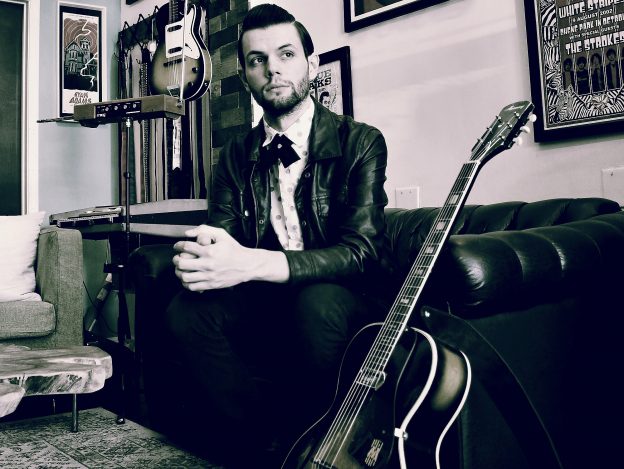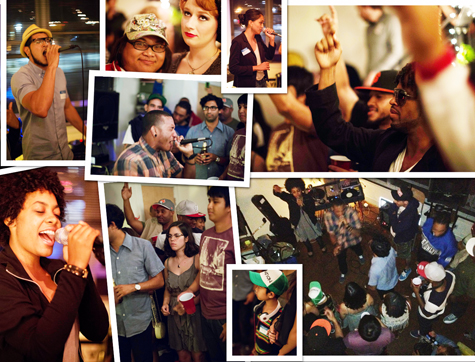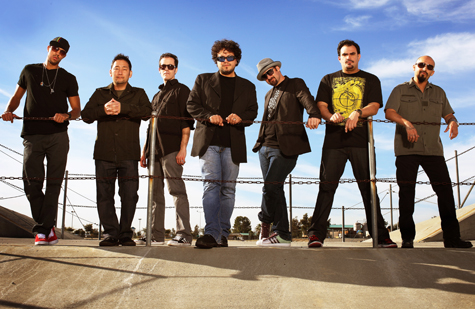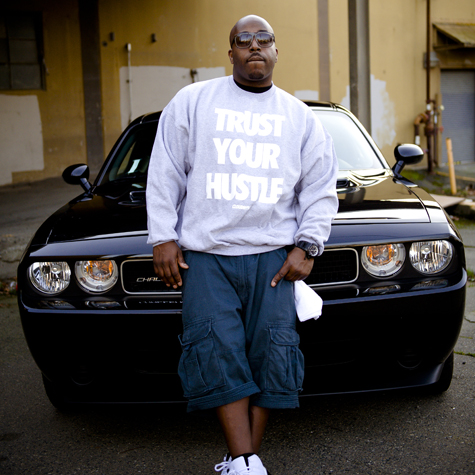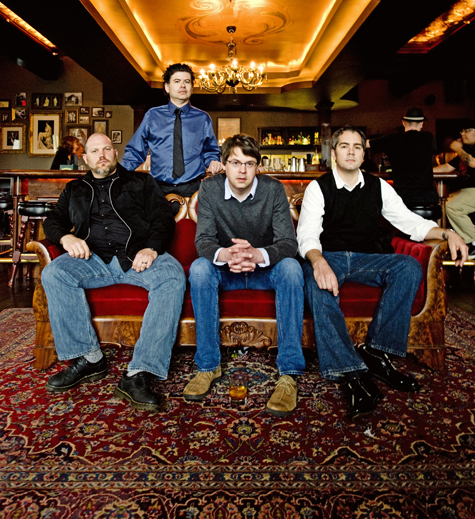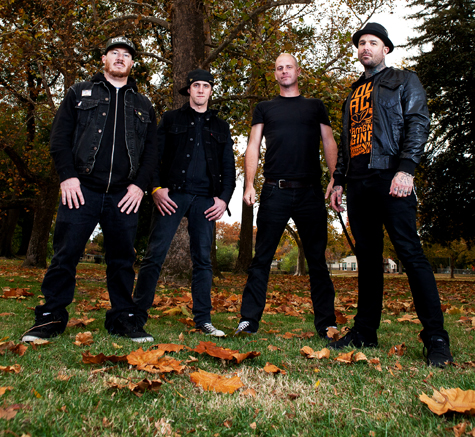Folk singers are the novelists of the music world. Each song they write is a different chapter that ultimately creates the story that they wish to tell. Brendan Stone, lead singer and founder of Sacramento outfit Blue Oaks, makes more than folk music, but the music he makes follows the folk tradition in that it tells a story—one that he’s been wanting to tell for nearly a decade.
Stone doesn’t make simple folk. His music is often darker than not and takes inspiration from genres across the board. He might end up making a psych record if that’s the music he’s gravitating toward when he’s writing. Genre isn’t so cut and dry for Stone. A Blue Oaks tune may start with some guitar plucking that comes straight from the mountains, but quickly turns into a track that will remind you more of Kurt Cobain than Woodie Guthrie.
Adhering to genre just isn’t Stone’s thing. He expresses a deep love of all music and wanted to contribute more than what Blue Oaks puts out into the world. So, he opened Stone Vintage Music Boutique (1409 R St. Ste. 103) just a few doors down from Ace of Spades to create a space for Sacramento’s music community. The shop will be closing for a time, however, while Stone heads out on tour, and he has plans to eventually relocate to a new location so he can add a full-fledged venue to the space.
We recently visited Stone’s shop to talk to him about Blue Oaks’ new album To Be Kind is Sin, religion and letting go of perfection. Blue Oaks released its new LP on Oct. 13 with the full band, including longtime drummer Cody Walker, with a seven-deadly-sins-themed album release show Monday, Oct. 30, 2017, at the Clara Auditorium (1425 24th St.).
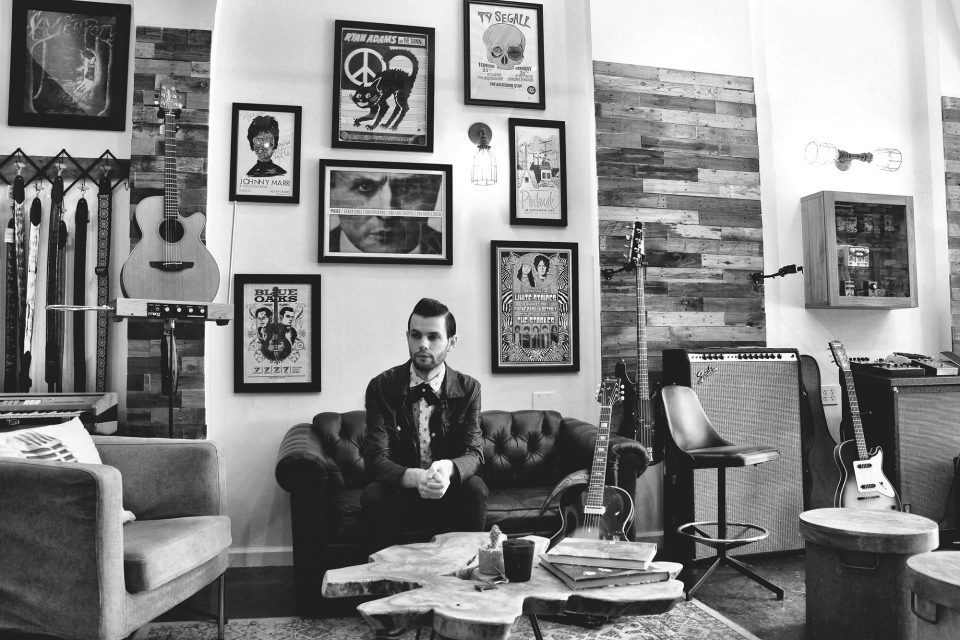
How long ago did you start Blue Oaks?
It started with me solo, playing acoustic, and that went from when I was 12 with another name but the same songs. From when I was 15 until now, it’s gone by Blue Oaks. From when I was 15 until 21, I played solo. It was the same songs, but not a lot of them were written yet from the album. Then I got Cody on drums when I was around 21 and he wasn’t a drummer.
You got him to do it anyway?
That works out better because there’s no competitive nature. It’s just primal instinct, which sounds better in my opinion. I feel like that’s part of what made the White Stripes’ dynamic work—that Meg was kind of a terrible drummer but she could play with feeling.
It’s just you two?
We went from solo to two-piece to three-piece to two-piece to four musicians, and I think last time we played Harlow’s we had five. Then it went back to a full-band setup again. The record release we’re doing on the 30th will have bass, drums, guitars, keys, violin—the full shebang of instruments. It’s really cool because that’s always how the songs sounded in my head when I wrote them, but it’s not always possible to do [what you want] live. You can’t copy yourself and play all the parts.
Yeah, that’s true. Once you’re live, you have to compromise sometimes.
In the studio you can, which is cool, but not in real life. The To Be Kind is Sin album is interesting because a lot of the songs, the folk songs from the record, were back from when I was 17 through 19. It’s funny because I was more of a folk singer-songwriter playing open mics and kind of built an audience, then started writing. I was really getting into Leonard Cohen, Bob Dylan and Nick Drake at the time, so it was kind of just happening subconsciously. You’re just listening to so much of that, it comes off on your music. I got a decent following from that, and I probably could have recorded a folk record. Then I got into Delta blues and started realizing there’s a genre that’s like folk-blues. That’s kind of where Bob Dylan was going. It worked out in a way, getting into Delta blues, then I started writing songs like “Nicotine” that’s on the record and “To Be Kind is Sin” and I was like, “Woah, this feels much more like what I want to be doing.”
I still hadn’t recorded the folk record, and I had all these new songs and I felt like those [folk songs] weren’t who I was anymore. They were just, like, diary entries.
What was it like once Blue Oaks stopped being a solo project?
I met Cody and we started playing live and it just gets louder and louder as you play with a drummer. We started creating builds. Like the song “Nicotine,” it builds up from this John Lee Hooker shuffle and keeps getting heavier. It has very strong dynamic—it goes quiet, loud. That’s one of the things that good rock music is known for doing, like the Pixies and Nirvana.
All that early ‘90s stuff.
To be able to go down quiet and kick up, and we started doing that, which really derived from getting sick of people talking over you.
I can believe that.
When you play open mics, a lot of the people are very attentive and want to hear every verse. They’ll notice if you annunciate weird. Then once rock guitar comes into it, you can’t really hear annunciations at all. So, there’s this weird beauty, in that folk is so pure. When you end up on rock shows playing folk music, people just talk over you. It just gets really negative. It got to this point where I felt—not disconnected from the Sacramento music scene—but I felt we could do everything we could do at the time. I was putting in so much effort at the time. We had played most of the venues. We had done most of the interviews. We had gone out of the city and realized that playing out of the city was more fruitful than playing in our hometown, which was upsetting. I ended up moving to Austin. Living there and seeing a real music city that’s fully developed and has been for a long time, it’s amazing. When you’re there, you start to realize how oversaturated those cities are and how everyone is trying to “make it.” It overshadows people who are doing it honestly. I ended up spending most of my time working, not doing music and it was really isolating. I ended up missing my bandmate, Cody. I ended up going into the studio and hiring session players. We did all the songs. Going in with the session players, [the music] just kind of molded itself, but they didn’t play it how I wanted it.
They just played it the way it’s supposed to be played.
Yeah, and it’s nothing against them, but their job is to just come in and play the music. It’s not the same as you vibing with someone. Cody and I vibe together really well, always have.
It sucks because the songs were finally recorded, a lot of them sounded amazing and I paid a lot of money to be there. I could tell that Cody wasn’t happy with it and it wasn’t what the record was supposed to sound like. I ended up flying home after recording the whole album.
We recorded the whole album again in Placerville. We scrapped that, too. It sounded pretty close to what I thought it should sound like, but the quality wasn’t there. Then Cody and I thought we would go with a minimal approach and just recorded it with two mics in a room. Almost like the early Black Keys record where it’s just raw. It sounded really good, but it wasn’t the same. So, we ended up going into Gold Standard Sounds. It sounds exactly how it was supposed to sound in my imagination, which is a good feeling as a musician or as any artist. Like I [would] guess if you’re a painter and it comes out exactly how you want it. It’s never going to be perfect, but it’s just letting go of the idea of perfection and knowing that letting go is what makes it good.
You seem like a nice guy. Why is being kind sin?
I’m not going to tell what it means because I want to leave it up to interpretation, but it did come from a feeling I had growing up. The record embodies the human state, the good and evil within people and the eternal battles we have on a daily basis. I think that everyone has that, whether you’re religious or not.
There’s a moral compass in everybody.
One thing I noticed growing up is that a lot of the most righteous people were the most judgmental, hateful, negative people. A lot of the bohemian, hippie, goth, alternative kids were the most welcoming, open-minded, beautiful people. You have these judgmental people who claim to be of Christ-like descent, and it’s crazy to me that they are the ones that are seen as the non-sinners. So, the title derives from something along the lines of that. Asking “is to be kind sin if this is how the world is?”
No amount of religion is going to tell you about someone’s life experience.
The songs actually have a lot to do with that if you listen to the record. I try to leave it up to interpretation. I’m not a religious person.
I didn’t think so.
I don’t judge those who are. It’s no opinion of mine to do so. I don’t really appreciate being criticized for my personal beliefs either. It’s important that light is cast upon the things that people are too scared to talk about and the album has to do with that. I figured there’s no better title to call it because it encapsulates that feeling.
Blue Oaks’ new album To Be Kind is Sin came out Oct. 13, 2017. Watch them play the new album live in its entirety on Monday, Oct. 30, 2017, at CLARA Auditorium, located at 1425 24th Street. Doors open at 7 p.m., a $5 minimum donation is suggested, 21-and-over only. Learn more at Blueoaksmusic.com or Facebook.com/blueoaksmusic.
**This piece first appeared in print on pages 20 – 21 of issue #250 (Oct. 9 – 23, 2017)**
Local guitarist Adrian Bellue can do things with his guitar that you didn’t think were possible. His “fingerstyle” playing is hard to describe in words; you almost need to see and hear it to believe it.
“What I do is a bit different,” he recently told Submerge. “I devote myself to breaking the boundaries of solo instrumentation and make every attempt to see how far I can take the acoustic guitar. I utilize percussion, rhythm and melody to fuse together a small orchestrated band from my fingertips.”
Imagine a bass line, melody, harmonics and percussive elements all coming from one guy, on one acoustic guitar. No loops, no effects pedals, just pure and raw talent. Years ago Bellue was getting way into martial arts and Buddhism, but after he sustained a major knee injury that required surgery, he had an “epiphany” about his music.
“I realized I could use all the same fundamentals from martial arts with the guitar, utilizing circular motion, empty mindedness, passing through the target, etc. That’s when I started developing my own techniques and exploring new tunings,” Bellue said.
Bellue’s debut album Draw Inspiration, recorded and engineered over the summer here in Sacramento by Brian Lee Bender all in single live takes, is now ready for release. See Bellue live on Dec. 29, 2012 at Harlow’s with ZuhG and friends at the Dr. Dre Tribute Show, which he is also calling his CD release show. Draw Inspiration is 10 tracks of moody, dynamic, technical acoustic guitar music perfectly fit for all these rainy days ahead of us. Toss it on and watch the puddles gather water while wondering to yourself, “How does he do that?” Visit http://adrianbellue.com or http://www.facebook.com/adrianbellue.
DLRN: Awakenings Listening Party
Saturday, Aug. 4, 2012
“Play a throwback,” someone yelled from the balcony, to which DLRN rapper 5th Ave coyly responded that tonight wasn’t about that. The loft space behind Naked Lounge on 15th and Q streets was well-beyond fire department approved capacity. Attendees squeezing in on kitchen countertops, staircases, overflowing onto the back patio and leaning over balconies to sought space to see DLRN perform its new record. My thought: Shush, it’s a listening party.
Saturday Aug. 4, 2012 marked a dual celebration for Sacramento hip-hop group DLRN. At midnight 5th Ave, born Sean LaMarr, turned 28 and played his new album, Awakenings, in front of friends and industry acquaintances for the first time alongside producer Jon Reyes and vocalist Iman Malika. Now a trio, Malika joined DLRN officially this year after making guest appearances on the group’s 2010 record, The Bridge.
The final record in the DLRN trilogy, Awakenings delivers on the promises made at the end of the previous EP The Bridge. Observe the titles in succession (No More Heroes, The Bridge, Awakenings) to understand DLRN’s intentions over three years. 5th Ave mentioned a clue to be discovered in “The Promise,” during our 2010 interview in Submerge, but it was not until I listened to the track tonight that I unlocked the message in, “Somebody pinch me / Because I ain’t never been so close to my dreams,” as a hint to Awakenings.
To commemorate The Bridge, DLRN threw a party at Beatnik Studios with tequila tasting, free sushi and kegs of Miller High Life. The Awakenings listening party was an intimate, invite-only affair, but those in attendance–dressed to the nines and a gorgeous crowd–were left to their own vices and devices to mix drinks in the kitchen, plunge hands into snack bowls and pilfer beers and sodas from the coolers, all on the house.
A toast is appropriate. DLRN are skilled in the art of party, putting their creative noggins together to give us a good time beyond the release show formula of door charges, security pat-downs and over-priced libations. Three Cheers.
While, it’s faux pas to request a hit at a listening party, it’s excusable since Sacramento rarely throws such events. Among friends though, 5th Ave entertained the request in the name of good vibes, performing “Trill Cosby” and “Dear Langston,” which he apologized for forgetting the words to. It spoke of where DLRN is at these days, looking ahead rather than letting the past carry them. “Dear Langston” has aged well, but Awakenings is ripe.
Post-set I was pulled aside to be interviewed by 5th Ave’s wife Glenda LaMarr’s son on camera. The little man who was in charge of donations (and did a fine job), asked me to sum up the DLRN album in three words, to which I replied, “Moody yet uplifting,” or something to that effect. WhiIe I mingled and tossed back complimentary booze, in the back of my head, I questioned if my quick assessment had merit. The listening party triggered a few reminders from my home sessions, and I hoped I’d spoken with justice to DLRN’s body of work.

On “Fear and Loathing” (featuring Stevie Nadir), Reyes’ production places noir-electronic-pop synths atop thundering drum breaks, a binding thread heard throughout Awakenings. Malika sings, “We’re living that night life, watch it all fall down,” until Nadir chimes in with, “Everything was beautiful / nothing ever hurt at all,” a reference to either Kurt Vonnegut’s Slaughthouse-Five or Christian rock band Breakfast With Amy’s debut album. Without slipping into goth chambers or inching too close to a reimagining of the Drive Motion Picture Soundtrack, Awakenings is an evening’s quest to greet the soft break of day. The daybreak comes in the album’s closer “Open Letter.” Over an ethereal beat, the vocals are at first chopped and screwed into a boozy grumble, but Iman comes in to lend the clarity, as Reyes’ production begins to rise from a clutter of red cups, blunt ash and streamers.
The album explores universal hang-ups among 20-somethings, the dedication made on “Homecoming,” but at the crux of the record rests a deeply personal song called “Good Company.” While performing “Good Company,” 5th Ave took a moment to make his wife, Glenda, blush front and center while she hugged her son. He got close, making eye contact and smiled at her through his verse. The track, clearly dedicated to her, bears a minor sonic kinship to Outkast’s “SpottieOttieDopealcious” as 5th Ave vibes out on the mic with refrains of, “Let the beat ride,” while Iman croons “baby baby”s to a space age funk track that could extend past the 10-minute mark and not seem indulgent. On “House of Matches,” 5th Ave hands over the keys to Iman and rides shotgun, a humble display for an MC. It speaks to DLRN being truly a group and not just rap bros who let a lady hang out and sing when needed.
Awakenings as an album in a Saturday night listening party environment with free liquor is a difficult sell. Awakenings is apropos for a Saturday night alone, drinking at first out of spite, and then falling deep into the music until you get a 4 a.m. urge to transfer it to your iPod and go for a walk to a vista to greet the sun to the build of “Open Letter.” 5th Ave might have found happiness, might feel closer to bringing his dreams to his waking life than ever before, but he’s not deserting the lost boys and girls. As the group explores label interest and management in Los Angeles, giving the record to Sacramento is DLRN’s first and foremost interest, as it always has been.
After many delays, Tribe of Levi release their first album, Follow My Lead
Tribe of Levi is a fixture in the Sacramento hip-hop scene as members of The People’s Revolution collective, but in the six years of being a crew the group never released a proper record. With the completion of Follow My Lead, the true schoolers are bringing local pride and world vision to the burgeoning scene.
The night before our interview, Chuuwee, Task1 and Poor of Tribe of Levi, among other local MCs, hit the KDVS airwaves for a session as part of the ATF: All Things Fresh’s last show of the semester. Tribe of Levi member, N.O.N. listened in while on the job saying, “It was a good display for the radio with good MCs.”
With N.O.N. on the job and Mic Jordan tending to “domestic things,” Poor represented for Tribe of Levi on the session. “While I was there, it hit me that this radio show was really special,” Poor said. “Not just because there were hella rappers there. But because this show was the only underground hip-hop you can hear on the radio. I’m not talking about Internet radio either. No diss to all the Internet radio cats out there, but I’m talking, in your car coming home on a late night radio. Feel me? On the FM dial! Plus, it is rare for me to be in a room with a lot of rappers that I consider really talented.”
The following morning, sitting down with Mic Jordan and N.O.N. of Tribe of Levi at the Javalounge, it was stated immediately, “Sacramento, per capita, has the best hip-hop scene in the country.” Without my provocation, Mic Jordan and N.O.N. came to the interview with a positive spin on the exhausting conversation of the local scene. Perhaps, it is time to stop worrying about what we don’t have and start appreciating the assets we do?
Like all talks with locals, it lapses into issuing complaints, issuing blame upon permits, shady promoters and community apathy. But as Tribe of Levi’s Follow My Lead record came together, the group saw past the common discrepancies to find inspiration and pride within the people who helped construct the album. As bleak as it can feel, an engineer working off the clock to perfect a mix, a local producer bouncing ideas and gathering resources and friends contributing guest verses and video treatments encouraged the group to see to it that Follow My Lead was released–even if they had to do it on their own.
The making of Follow My Lead began after a trip to Austin, Texas, for SxSW in 2011. The group returned home rejuvenated from the love it received in the southern oasis. An unfinished record entitled Levitation, was waiting for them at home, looming over their heads in limbo after issues arose with a producer who decided his beats were off the market, despite the songs already being laid down.
“We felt a little bogged down after spending five years trying to do Levitation,” Mic Jordan said. “It started to feel like an albatross.”
Mic Jordan opened the front apartment of his Midtown property to producer Lee Bannon. With Bannon a door knock away, the group began recording in his living room. The producer also linked up Tribe of Levi with New Jersey producer Akili Beats, who handled a majority of the production. “At first we were re-arranging beats,” Poor said. “Switching one out for the other, and so on. Until eventually, we decided to just write a whole other album. Lee Bannon played a huge role in helping the Tribe of Levi get a second wind.”
In August 2011, Tribe of Levi offered insight into the progress of Follow My Lead with a Jae Synth-directed video for “Things to Do” featuring fellow The People’s Revolution member Bru Lei. Shot at Mic Jordan’s home and around his 19th and G block, “Things to Do” opens with Poor riffing, “I’m on my Sacto shit today/I’m on my grown man shit too,” which is telling of the group’s mindset. Each rapper on the track sets up the closing stanza of his verse with, “I’m a grown ass man/I got things to do.”
On Follow My Lead, the group attacks each track with a no frills mentality that runs deeper than just on record. Mic Jordan had few qualms with stating that the record will be their push to take the group global, rather than fall victim to the small town thinking associated with the city. On “Things to Do” he raps, “Our community is crawling with future kings/But usually we stupidly ruin things.”

Photo by April Irene Fredrikson
“Historically and even presently we deal with this conundrum of being on the verge of being a big city and the verge of being a small back water,” he said. “There’s this strange confluence of really motivated, driven people and then you get to a certain level and you get shut down by retrograde, backwards, close-minded people who are plugged into a good ol’ boys network trying to preserve a status quo that’s actually kind of weak. It’s just rough.”
Much like Mayor Kevin Johnson’s vision, Mic Jordan spoke of Sacramento as a “should be” destination city, citing the climate, the capitol and its beauty as attractions. The deterrent to a blossoming music scene, to him, comes down to overlapping enforcement agencies and regulations on live music that make it so little can be done.
“International visitors can’t even get into the 21-and-over venues with their passports,” he said, which lends restriction on putting Sacramento hip-hop on the global scale.
“The idea for this album was to be able to do something that had national appeal,” he said. “If we are able to make the jump to being national or international, I hope I can put some sort of bridge or infrastructure in for the rest of the artists.”
Historically, the artists from the capitol have not done much for the city that raised them, and it continues with bands like Trash Talk repping Los Angeles harder than here or Death Grips hiding out but only playing three shows locally. Listening to the Beastie Boys’ Hello Nasty record, a Mixmaster Mike phone call before “Three MCs and One DJ” features Mike saying he’s out here, but as N.O.N. notes, “It’s just a trip because you don’t see people like Mixmaster Mike out here doing events.”
“People don’t associate Sacramento’s biggest acts with Sacramento,” Mic Jordan added. “People don’t know that Blackalicious went to Kennedy. Other than [Brother] Lynch [Hung], he’s the only major act from here that was associated with it. But things are changing with Chuuwee, Death Grips and Bannon. Maybe the tide is turning finally. We’ve just got to figure out how to push it further.”
Follow My Lead is littered with hometown pride as the city’s name is invoked numerously throughout the record. It boils down to the people who helped make the album possible. Tribe of Levi is deeply rooted, recording tracks in Bannon’s kitchen and taking them to be mastered by PeteSpace at SoundCap Audio. “Everybody seemed to really believe in what we were doing and made it feel like they were participating in something worth while,” Mic Jordan said.
N.O.N. said he was recently searching Pandora Radio to see how many local MCs had stations, only to find artists like Mahtie Bush and Death Grips on the server. The initial push for Follow My Lead will begin on the grassroots level, as the group intends to handle its own public relations by writing letters and emails to the friends they’ve made internationally while traveling. The group will follow up the album with the delayed Levitation record, which is shaping up to be more of a mixtape, as well as solo projects from each member. N.O.N joked, “There’s a reason you have a mic in your house instead of a horse,” and it once again harkens to their grown men mindset.
“There’s not many people from Sac who are up on Pandora,” he said. “We’ve been keeping it real underground for the most part. We’ve performed so many songs that people can’t buy or listen to in their car. We’re putting our record on there.”
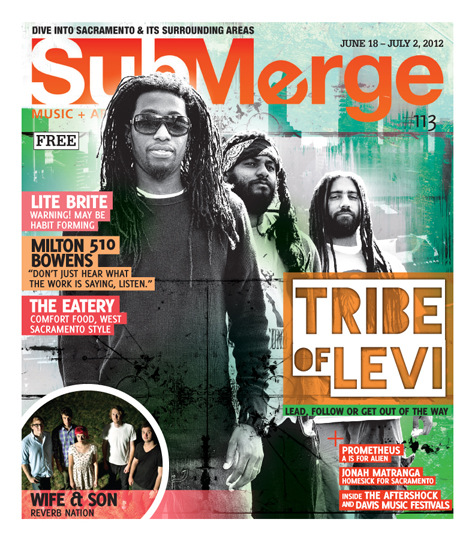
Tribe of Levi’s album release show for Follow My Lead will be Tuesday, July 10, 2012 at Harlow’s. Follow the band on Twitter (http://Twitter.com/tribeoflevi) for more updates and information. You can listen to some of the tracks from the album on the group’s Reverb Nation page (http://www.reverbnation.com/ and search “Tribe of Levi”).
Ozomatli unites cultures far and wide, and people young and old
Multi-tasking. It’s an ungodly buzz word that has more or less come to define our modern existence. Job titles now seem to be a never-ending string of hyphens or slashes; Web browsers allow for infinite tabs; that little waterfall thing in the upper-right corner of your Facebook page lets you know when one of your friends likes a photo of someone you’ve never even met. You’re busy. We know. So is Ulises Bella of Los Angeles-based band Ozomatli. When Submerge caught up with him, he and the band were hard at work on a variety of things.
“We’re not very good at multi-tasking,” Bella says with a big laugh. “We’re trying our hardest, though, to multi-task up in here.”
Bella reveals that the band has just started making demos and setting into motion a new Ozomatli LP, which would be the band’s first studio album since 2010’s relentlessly groovy Fire Away, an aptly named album that boasts an arsenal of sounds both exotic and domestic in flavor. However, at the moment, Bella (who contributes his talents on saxophone, keyboards and other instruments) and company are working on a project with a younger audience in mind. In between their rigorous touring schedule, which sees them on the road most weekends, at the very least, Ozomatli has been working on their first children’s record under the moniker Ozokidz. This isn’t a radically new idea for Ozo. Bella says that the band has “always been down for playing for kids and interacting with kids,” but as members of the band had their own children, making an album for kids seemed to make sense.
“Our fans are getting older, so a lot of them have kids, and what really put it over the edge was when we were the super music friends for a couple live shows of Yo Gabba Gabba,” he says. “That really made us say, ‘We have to make an album,’ because a lot of our music already kids relate to a little bit.”
Reminiscing about the music he grew up on, the stuff that he gravitated toward when he was a child, Bella speaks of a rich personal musical tradition. As could be inferred from Ozomatli’s music–a blend of, well, just about anything: Afro-Cuban and tropical rhythms, reggae, hip-hop, pop, good ol’ rock ‘n’ roll all deftly woven together with positivity and a purpose–Bella’s musical upbringing was quite diverse. Through his father, he learned to gain appreciation for the great composers, such as Bach and Vivaldi.
“A lot of baroque music really stuck with me,” he says.
Beyond that, the music of his parents’ heritage and popular music also played significant roles.
“My dad was from Spain and my mother was from Mexico, so my mom was super into Trio Los Panchos, a lot of Beatles, obviously, a lot of Beach Boys,” Bella says. “There’s this party music from Spain called rumba flamenca. The only thing I can compare it to is the same beat as The Gypsy Kings, but less commercial-y, but it’s very much party music. So all that kind of stuff was in me. Also, my friends at the time, the kids I was growing up with, were very much into breakdancing and break dance music, so a lot of that electro hip-hop sound, kind of Kraftwerk vibe type stuff, really resonated with me, and to this day I’m into that stuff.”
This sort of diversity, as well as the varying backgrounds of Ozomatli’s six other regular members, plays a huge part in the band’s songwriting process, which Bella describes as pure experimentation as to what styles will blend the best.
“When we were in each other’s presence, the band was almost like a musical conservatory,” he says. “Everybody came from these different traditions, and there were a lot of things each of us didn’t know about. So, whereas one guy probably listened to reggae all his life, he probably didn’t know shit about cumbia. But then another guy probably knew a lot about cumbia and tropical music, but didn’t know much about reggae. In between that, there was kind of one of those things where a guy was playing a cumbia, but to him it sounds like a mutated reggae song, so he’s playing a reggae bass line over it, and in a weird way it shouldn’t fit, but it fits.”
And Ozomatli never stops gaining new influences. As they live, grow and experience so too does the band’s music.
“A lot of it also has to do with what people are into at the moment,” Bella explains. “Obviously when we first started on the first album, we were super influenced by Afro-Cuban music, and the hip-hop influence was huge because of Chali 2na and Cut Chemist, the world music vibe of putting in tablas and all that stuff. And through our travels, especially through the country and through the world, you start picking up different things, slowly those influences start going into the music too.”
Bella says the Ozokidz album is about 95 percent done, but still doesn’t have a firm release date, but it will be released on Hornblow Recordings/Megaforce/RED, which has also released They Might Be Giants’ children’s albums. In the following interview, Bella talks about some of Ozomatli’s interesting experiences working as U.S. State Department Cultural Ambassadors.
Speaking of your travels, you guys visited Nepal a while back. I’ve always wanted to visit there, and I’m not sure why. I think it was because of Raiders of the Lost Ark. What was that like, and were you exposed to any of the local music there?
Totally, and the crazy thing about Nepal is that it was one of our first trips as cultural ambassadors, right? We show up in Nepal, and it was completely coincidence, the day we get there is the day this huge religious festival called Shivaratri, which is all about Shiva and millions of motherfuckers from all over India and all over Nepal come to this temple to do offerings. The lines that go into these temples are miles long. Now the other thing that distinguishes this festival is that all kinds of cannabis use is legal for that day, so you see all these kids rolling up these monster spliffs, and you’re like, “Whoa, what’s going on here?”
And then, trip out on this. This is like some National Geographic shit. We were like, “Whoa, what a party!” It’s really psychedelic because there are all these speakers blaring these chants. It’s fucking bananas. Then we end up in this courtyard that the government set up for the sadhus, who are Hindu holy men. Now these cats basically renounce all material items and shit–loin cloths and dread locks, bro. They reserved this square strictly for them just to get high. You walk in there, and you’re tripping out, and they’re asking you to come in there and smoke. They’re like, “No, please, sit down.” They have these huge bowls of weed… It was quite a scene.
And when we were there, there was a cease fire between the Maoists and the government. I guess every other day in Nepal there are general strikes. We were really tripped out, like this is really an electric environment.
When we played the show, you know how there’s the railing between the crowd and the stage?
Yeah, where the photographers sometimes stand.
Exactly. Dude. The gate was about 100 feet away from the fucking stage. We were like, “Why is it so far away? How are we supposed to connect with this audience?” Then the dudes who are breaking it down are like, “Look, if for any reason the crowd doesn’t like you, or you have technical difficulties and you can’t get your shit together, they’re just going to start throwing rocks at you.”
I’d just gotten food poisoning, so at this point, I’m sick as a dog. I’m like, well, fuck it. Even if they throw shit at us, we’ve got to bring this barrier closer to us. This is just ridiculous. I think we got it 50 or 60 feet away from the stage, played the show, and it’s estimated over 10,000 people were at this show, and it was one of the largest congregations of people outside of strikes and politics and all that kind of shit that was going on. It went off really really well. It was old people, young people, all kinds of people.
The thing is, going into Nepal, I knew that maybe 10, 15 people tops knew who we were [laughs]… But it’s an amazing litmus test to see if your music stands on its own and can just communicate, because we just played, and people dug the music and reacted to it immediately. So it wasn’t the hype of Ozo, or our legacy or our reputation didn’t precede us.
How did you get involved with the cultural ambassadorship, because that’s a government appointment, isn’t it?
Basically what happened was this woman hit us up about it to renew it, and it was at first a big point of debate with us, because obviously there was a government connection, and we were still in the middle of the Bush administration, and it was like, how do we want the world to perceive us and how do we want the world to react to us? Will they think that we’re peddling bullshit, you know? So a big thing with us was that we were really sensitive about how we were portrayed, and we were really sensitive about local interests. A good example with that was Nepal, there was one person there who was like, “They’re always striking here. They’re shutting down their country. Maybe you can talk to the kids about how it’s not such a good idea.” Actually, I was kind of jealous of them, because they can hold the reins of power and immediately take control of society. I don’t even think that there’s been a general strike here in Los Angeles. There have been times when demonstrations have shut down the city, but I was of the mind that I envy these kids, that they’re able to organize like that and shut things down.
Well, you guys formed at a labor demonstration too, didn’t you?
Right. That was the other thing. We were like, “Are you sure you want this band to do this kind of work?” For me it was about creating our own story and creating our own connections. As much as we have stereotypes about these countries, they have stereotypes about Americans too, and why not break down these stereotypes and show we’re more the same than we are different–especially when it comes down to common people, working class people. The same shit some guy has to deal with in Egypt is probably the same shit some dude in the Midwest has to deal with.
It’s true. There are little differences, but the big things are the same. Everyone has to pay rent and make sure there’s food on the table for the kids and stuff like that.
Exactly. There are tons of things that divide us, whether it’s our governments, our religions, our outlooks on society, but when it comes down to it, everybody needs a place to stay, clean water, clean food, education. And that’s the thing in the United States that we take for granted.
Are you still in the position now?
It’s kind of died down. We did a lot of work for a while. We visited a lot of countries that a lot of bands have never been to, and I think we were just like, “We did this work, but now we’ve got to focus on some other shit real quick.”

Ozomatli will play Ace of Spades in Sacramento on April 6. Doors open at 7 p.m. and tickets are $20. They can be purchased through http://www.aceofspadessac.com/. For more info on all things Ozo, go to http://ozomatli.com/
Mean Doe Green (aka Doey Rock) has tasted success, but it hasn’t sated his appetite
It’s a quiet Saturday night in New Era Park. Smack in the middle of this seemingly lifeless block between D and E streets is the firehouse, a distinct two-story brick building with ghostly white faces engraved above the front entry. This is the home of SoundCap Audio, the tracking and mixing studio that has produced albums by some of Sacramento’s top hip-hop artists. I’m here to meet with Sacramento’s veteran MC Mean Doe Green. You may also know him as Doey Rock.
Born Kahallie Oden, Jon Doe was the first moniker Green chose for himself when he started rapping. That soon evolved into Doey Rock. Incidentally he dropped “Mean Doe Green” in a rhyme, and as someone who adopts different personas in his music, he has embraced Mean Doe Green as an alter ego ever since.
“It was a way to reintroduce myself to people,” he later explains. “But I’m never afraid of Doey Rock, because he did a lot for me, too, alter ego-wise.”
Back at SoundCap Audio, engineer Pete Rodriguez answers the door and leads the way past the sound booth to the mixing room. The place is dimly lit and quiet. We shoot the breeze while we wait for Green to arrive. The young kids, some of them as young as 17, are the ones really tearing it up in the local hip-hop scene, he tells me.
Minutes later Green strolls in and makes his way to the black leather couch across from Rodriguez. His voice booms, loud and lucid, but he’s all jokes and smiles. This place is a safe haven for his music, he says, where he feels comfortable enough being himself while recording.
He and Rodriguez have been a team since Green began recording at Sound Cap more than two years ago. Green’s 2010 release Mind Candy Re-wrapped, as well as mixtapes Black Suits and Shovels and Hard Hats and Hand Grenades, both released last July, were recorded here. Now the two are working on the final touches of Shade Proof, Green’s upcoming LP, which is scheduled for release on Feb. 21.
It has been a three- to four-month project that has resulted in a very aggressive, “in-your-face” approach, Green later discloses, which he says will likely make listeners either love or hate him. Teaser tracks “Be Great” and “Thankful” are already posted online, both of which have attracted attention in the hip-hop blogosphere.
Though it features the likes of R&B artists Hello World, Raekwon, Tommy Nova and Arty Fresha, Shade Proof is meant to highlight his capabilities as an MC, front and center, Green says.
“I felt like I should put more of myself [into it], because I think a lot of albums that come out just have too many features,” he explains. “Hip-hop albums these days are just about who you have on the album, as opposed to the artist that’s presenting the album.”
Green only exposed Submerge to four select tracks from Shade Proof.
“I’m picky as fuck about my music being played for people,” he says.
But in those tracks alone, which include “Be Great,” Green opens up over grimy beats. And there’s a lot to open up about. He had a neglectful father. He grew up in the hood and has seen his share of “wild shit.” He watched family members fall victim to drug abuse. He watched someone get killed in his driveway.
At the end of the day he’s a street dude, he says. But that’s how he met Raekwon of Wu Tang Clan at age 17, before anyone knew who Wu Tang Clan was. That’s how he got introduced to the game of hip-hop, and he’s been at it ever since.
“I’ve been feeding kids off hip-hop, and I’m proud of that,” he reminds.
Mid-conversation, Green asks Rodriguez to bust out the weed. Rodriguez pulls out a massive nug the length of a pen, and the two get to business rolling a joint.
“Welcome to the city of trees, God dammit,” Green says.
Soon enough they’re getting ripped, and Green is answering my questions with more and more ease. Next thing I know he’s getting stuff off his chest, stuff about the commercialization of hip-hop and about the passion that fuels his songs. The following gives a taste of the conversation.
When do you think [Shade Proof] will be done?
It’ll be out on the 21st, because that’s the date we set, and I don’t have a choice. And when it’s out I’ll be happy with it, because I work well in pressured situations for some odd reason. But I’ve been MCing for so long at this point finding comfort zones is different now, because quite frankly I’m not in the same hunger state that I was in four years ago.
What do you mean?
Yo, MCing is about hunger. This shit was created because people didn’t have shit to do when they was starving and they wanted to put their talents on display. That’s what MCing is about, “I have something to say, hear my voice.” The greatest artists were hungry artists, if you think about whether it’s Tupac and Big, or go back further, Run DMC or Raekwon or Afrika Bambaataa, or whoever. They was starving, not only for attention, but: “Yo, I have a talent to put on display, I have a message. This is my style.” Hip-hop is about your style and your energy as a person. So me doing this for so long, and doing it successfully, you have to find hunger, you have to have a reason. Driven… I have pockets of, “Well I don’t even like rhymes,” because I don’t have shit to say. I done fuckin’ made it to the suburbs. That nigga from Elder Creek? Where I’m living at? Damn! I’m so realistic with my music, I don’t have anything to cry about or complain about, so it’s hard for me to find pockets of hunger. But let an MC think he’s better than me. Those are my driving forces now. It’s different driving forces as a real MC, because I’m not going to write no fabricated shit. I’m not going to rap about binges and mansions and luxuries, this, that and the other. Now I’ve got to find pockets of, “Oh, I feel hungry,” or “Oh, I heard a Chuuwee song, damn that little mothafucka tight! I gotta do that.” But it’s healthy competition, not like I’m hating on him, but that inspires me now.
What were you thinking about when you wrote [“Merlot Murder”]? I felt like there was some anger in that song.
Anger toward hip-hop, right?
Mhmm.
You know what? As much as I felt like I gave to hip-hop, and I tried to stay true to it, I felt like it kind of stabbed me in the back in ways. I feel like it didn’t afford me opportunities that it should have. I don’t know if it was being from Sacramento, I don’t know what it was, but I feel like honestly, as true as I stay to this sport, look at what hip-hop is right now. You got a lot of pop bullshit out, you know, it’s just so watered down.
What’s the ultimate example of watered-down hip hop to you?
When you want a better life for your family and where you come from, I don’t blame people for doing what they do to make money. I guess I’m just so personal with hip-hop that I hate that it comes at the expense of hip-hop. So, watered down to me would be–and it’s a thin line when I say this and it’s a slippery slope–anything that goes commercial to the point that you know what you’re broadcasting is not from the heart. The problem with saying names is you don’t know what their family situation was, and I always am careful about that… See it’s a lot of driving forces as to why we do what we do in this game. The problem is, look what hip-hop has become because of the money and because of the bling-bling era. I guess I would lay the blame there, the bling-bling era of hip-hop fucked it all up. Anytime you give people with nothing a vision of people that didn’t have nothing and now they got something, anytime you broadcast that too much, it becomes, now the people with nothing are rapping about shit they don’t have because they want to look like that. And it just misconstrued every damn thing.
Why do you think you weren’t [rapping about personal stuff] before?
I just wasn’t. I was just on the MC shit, let’s focus on the art and this and that. We’re not going to talk about the street. I didn’t want my gimmick to be street shit or gangsta shit, I don’t claim to be a gangsta in the first place… I’m not doing it for any specific reason. I guess at this point I just feel like I should get it off my chest.
Doey Rock will celebrate the release of Shade Proof (out March 13) on March 16, 2012 at Harlow’s. You can listen and download the the album at Audiomack.com/artist/doey-rock. The show starts at 10 p.m. and will cost $10. To order tickets in advance, go to Harlows.com.
Endings, as the saying goes, often lead to new beginnings. When Sacramento indie rock band Holiday Flyer called it quits in 2002 after almost 10 years as a group and four full-length albums, its members found new avenues to express themselves musically. Three-fifths of Holiday Flyer–which began as the brother/sister duo of John and Katie Conley, but grew into a five-piece band by its final album, 2001’s I Hope–went on to form Desario just two years later. Frontman John Conley, bassist Michael Yoas (making the jump from bass back to his first instrument guitar in Desario) and drummer Jim Rivas were joined by bass player Mike Carr. Desario released its first album, Zero Point Zero, in 2009. On February 28, 2012 the band will put forth its sophomore effort, Mixer, which shows that even after many years as vital parts of the Sacramento scene, the guys of Desario are still looking for new ways to expand their craft.
Yoas produced and engineered the entirety of Mixer, which was mixed by Larry Crane (who has worked with Elliott Smith, among others). Last time around, on Zero Point Zero, Yoas recorded everything except the drums. He says he and Conley had been playing music together as far back as the ‘80s. “We started in punk bands together in high school. We wrote together back then, and then I didn’t play music for quite a while.”
It was eight to 10 years by Yoas’ estimation that he hadn’t played music until his old friend lured him back into the studio. Yoas laid down bass for a few tracks on Holiday Flyer’s third album You Make Us Go and enjoyed an expanded role as a fixture on I Hope.
“Jim [Rivas] and I joined and put our stamp on it with bass lines and drums and percussion and added some arrangements,” Yoas says. “But for the most part, Holiday Flyer was John’s vision.”
Desario is an entirely different animal. Instead of leaning on one songwriter, the band takes a four-heads-are-better-than-one approach. In fact, the title of the album refers to the fact that the songs on Mixer were a group effort.
“It really is a band effort,” Yoas explains. “Other than the lyrics–John writes all the lyrics–it really can start with any one of us.”
This time around, the songs came together in Desario’s practice space, evolving from jams to the fully realized recordings found on Mixer. The album has a layered, sometimes spacey sound that’s imbued with underlying warmth. Songs such as “Victoria Island,” which begins with a sort of watery synth burble, stretches out into a well-paced five-and-a-half minutes of absorbing rock, layered with shimmering, distorted guitars. It’s indicative of what you’ll find on Mixer–songs that are a bit challenging, yet easy to get lost in.
On an early Saturday morning, Yoas took the time to answer some of our questions about how the album came together, and revealed how Desario thrives by keeping their songwriting process fluid.
How was the process of producing Mixer as opposed to Zero Point Zero?
Kind of arduous at times. When it’s your own music, you’re never quite sure if you’re going in the right direction or not. You’re constantly second guessing yourself. But in the end, we’re really happy with it.
Are you at all interested in producing other people’s work, or have you produced other people’s work?
Yeah I am. I’ve recorded some demos for a couple of bands. I haven’t finished them through yet, but I’m definitely interested in recording some other bands in town and getting more into that.
How is it working on someone else’s stuff as opposed to working on your own?
Honestly, it’s a lot easier for me. I have no problem giving my opinion on something, or if I’m hearing something to add or take away, it’s pretty easy giving my opinion and feel good about it. I am an avid music fan as well. When you hear something, just throw it out there.
When you’re giving feedback when you were working on Mixer, did you find that you had to be more tactful in giving your opinion since you’re a member of the band?
Absolutely…
Do you find yourself holding back sometimes? You’ve known the guys for a while. It must be an interesting dynamic in the studio.
Oh, you mean giving Desario advice?
Yeah.
Oh no. I’m not tactful at all [laughs]. As far as the guys in my band, I think at times I might have been kind of hard and had a vision and did everything I could to get out of them what I was hearing, knowing that we could all go back in the end as a group and sort things out and edit things. I definitely wanted to try to get a lot of different takes of everything just to have options.
As far as your vision for this record, is that something that came through in the writing of it or afterward when you started recording?
Definitely in the writing. We were going through a phase with this batch of songs. This batch of songs probably came together over the course of three years or so. We were trying to do things–for lack of a better term–more intricate and more elaborate, I guess, and not by choice, but for whatever reason it’s the place we were in for a couple of years. Just looking to make it as interesting with synthesizer and other elements we didn’t use at all on the first record.
You mentioned that the songs came together from jamming as a band. How did you like working that way?
It’s funny, all of us in the beginning were like, “It’s tough for us to jam. It’s hard to come in without any starting point and create music.” As we evolved as a band, we found that we all played so well together, it was really easy to jam–starting with one of Jim’s drumbeats or Mike’s bass lines. It could be anything that would make someone say, “Hey, keep doing that,” and that’s how most of the songs on Mixer started…
There has been many practices where we don’t have any shows to practice for, or we’re not recording anything. We’re very diligent. We have a scheduled practice night every week, and regardless of what’s going on, we make it a point to go in that night and practice, even though we have no reason to be there, just to see what might come out of it.
In that regard, are you guys writing all the time now? Has that process opened you up to be more prolific songwriters?
I think so. We’re constantly writing. With the stuff that we’re writing after Mixer, we’re taking a slightly different approach. John and I are trying to noodle with some ideas together and bringing them to the band to see if they think it’s worth moving forward with those ideas at this point. We’re constantly trying to change how we song-write, just to keep it interesting and so we’re writing different kinds of songs all the time.
So you’re working on stuff with John for a next record?
As a band we’ve already got six songs written. We basically have all the ideas for another album’s worth of material that we just need to hash out as a band and get arranged and just get it completed.
No rest for the weary, then.
Exactly. Yes, we’re always writing, but we definitely go into practice now with an idea of what we want to do instead of going in without any purpose.
You guys have a listening party coming up for Mixer before playing the CD release show on March 3. What do you have planned for the listening party?
We’ve got two hours at Phono Select. We’re going to let the CD play a couple of times in the store. It’s going to be available for sale. We’re going to put out some beverages and snacks. We’re just going to make it a real casual thing–come in, check out the record and enjoy a beer or a glass of wine and just have a good time.
Is it more nerve-wracking to play the new songs live or watching people listen to the CD at the listening party?
That’s a good question. I’m a little more anxious about watching people listen to the record than playing live. Playing live, obviously, I’m more focused on what I’m doing than watching the reaction of people listening to it.
Desario’s CD release show will take place at Beatnik Studios on March 3, 2012. Joining Desario will be Tremor Low from Oakland and Hearts + Horses.
Ross Hammond discusses his new album with The Ross Hammond Quartet and His New Muse
Interviewing Ross Hammond on a Friday afternoon while his wife was out of town meant a secondary task of taking his 18-month old daughter, Lola, for a stroll around the 17th and L block of Midtown.
Lola led the way, while Hammond and I discussed his upcoming Ross Hammond Quartet record due this month. As we strolled and pointed out flowers, dogs and trucks (Lola loves trucks and buses), it became apparent the little blondie was responsible for changes and inspiration in her father she’ll not understand for years. The record, Adored, and Hammond’s artistic growth displayed on the album would not be possible without her.
Our walk began in the alley outside Old Soul Coffee. We did roughly three laps of the block and if we stopped the question was posed, “Lola walk?” In answering, Lola formed her first contribution to the interview tape “Lola walk.” Many of Hammond’s responses were fractured with quick “stay close” requests, but we eventually got down to brass tacks. The immediate information to hash out: Who are the players in the Ross Hammond Quartet?
The ensemble came together mostly through the intricate web of the jazz scene involving booking, travel and of course, collaboration, although Hammond first came to know each member from owning their albums. Whether on stage or in the studio, he said he had several surreal moments that left him pondering, “How did I get here?” The Quartet comprises Hammond on guitar, Vinny Golia on saxophone, Steuart Liebig on contrabass guitar and Alex Cline on percussion. Hammond said he’d known Golia from booking him a gig at the Cool Cat Gallery on 24th–back when it existed–and Cline in a similar fashion. Cline is the twin brother of legendary guitarist Nels Cline, who’s currently playing lead guitar in Wilco. “It’s freaky, dude,” Hammond said regarding the Cline brothers. “They’re identical and both really tall.”
As for Liebig, “I don’t know how I met, Steuart… I guess through the scene.”
He played three to four gigs, including the In the Flow Festival in Sacramento last year, with the members, planting the seed for the quartet. After he’d enlisted the three musicians for a studio session in Los Angeles, the makings of an official ensemble came to fruition.
When it came time to name the project, Hammond was surprised by the other members’ suggestion of naming the quartet after him. At 34, Hammond is the youngest member of the group while the rest were born as far back as the ‘40s. It is a humble and impressive gesture coming from three renowned L.A. jazz musicians who have each had ensembles bearing their namesakes.
“For lack of anything better that’s what it is,” Hammond said. “I’ve never had a quartet before. I also feel like I couldn’t replace any of those guys and still call it the same thing.”
Recorded at Newzone Studio and engineered by Wayne Peet, the album was tracked in six hours with only a few songs needing alternate takes. It’s a feat that speaks to the veteran musicianship of Hammond’s quartet. Hammond would play the riff he had in mind for a song and the ensemble would offer a nod or “OK”–no further tutelage required. He said after each track, it was understood that it felt good and they would move on to the next song.
“Playing with these guys it’s just about staying on the wave,” he said. “You don’t have to give them much instruction at all. I think one of the instructions I gave Vinny was, ‘OK, as soon as this song starts you have to come in like an elephant,’ and that’s what he did.”
Adored is carved from a foundation of folk songs with the title track being a lullaby Hammond sings to Lola at bedtime. Hammond said three of the songs are lullabies he sings. After she’d go to sleep he would figure out the notes and write out the lullaby. The writing is at its most encrypted on “Maribel’s Code,” in which the melody is an intervocalic code built from Lola’s initials: LMH.
“Most of the stuff I write has either a dedication or an idea, be it political or romantic,” Hammond said. “I’m never just like, “oh this is a cool riff, I’ll call it…’”
Three years ago when I first interviewed Hammond, he shared a similar sentiment. The inspiration behind the album title An Effective Use of Space came from a saying his wife frequently used. He said it’s one she still uses to this day. Hammond listed his wife as still his deepest muse, but the birth of his daughter is the primary source of inspiration behind Adored.
The immediacy of the recording is palpable, but it’s done in maturity. Hammond said the difficult task in preparing the music was giving the songs a collected feel, but without being united to the point of bleeding the songs together. Adored roars in, spastic and angry, with “Adored” but as “Sesquipedalian” mellows out it introduces the soft lullaby of “She’s My Little Girl.” Consider the album to be much like Hammond’s day-to-day with Lola; awake at 6 a.m. and full of energy, a settling in period, a mid-day walk with small fits of exuberance and crankiness, a lullaby for a nap or the night’s tuck-in. It is all lovingly expressed in the sea changes of Adored.
“Alex [Cline] told me he doesn’t think you mature as a musician until after you’ve been a dad,” Hammond said. “The gist of it was you stop trying to impress people and focus on filtering this feeling you have and this beautiful thing and turn it into a song. Your muse is different. The goofy songs aren’t there anymore. Having a kid forces you to grow up and you grow up in everything. If anything it’s more purposeful now.”
With the particulars of the album discussed and rocks and leaves in our pockets courtesy of the tyke, Hammond asked Lola, “Wanna go swing? Lola swing?” She offered her second sentence of the afternoon; a sharp “Lola swing.” With that, they strapped into a bicycle and road off to the park.
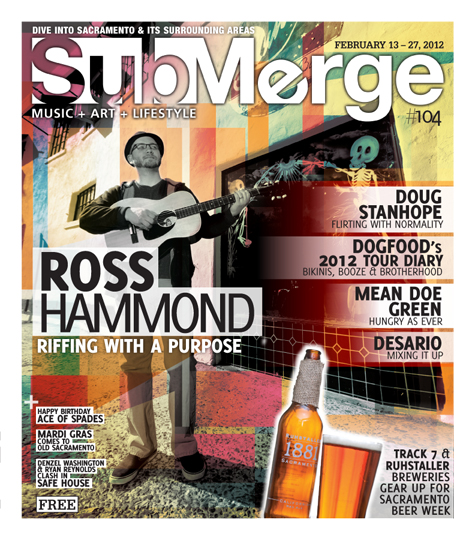
Adored by The Ross Hammond Quartet will be available Feb. 27, 2012. You can preorder it now at Rosshammond.bandcamp.com/album/adored and also listen to the title track. Hammond and co. will throw a CD release party on the very day of its release at Luna’s Café in Sacramento.
Sacramento’s Lonely Kings are underground rock heroes
Although they may never have sold a million records, traveled to gigs via private airplane or experienced much else commonly associated with rock stardom, Sacramento-based Lonely Kings have long since established themselves as underground rock legends. They are a “band’s band,” if you will, and chances are, some of your favorite artists from back in the day have these guys’ cell phone numbers on lock. Formed in the early ‘90s by vocalist/guitarist/primary songwriter Jake Desrochers and drummer Jason Wilkinson (the two remaining original members; the group is now rounded out by bassist Emile Janicot and lead guitarist Johnny Deluca, both of whom have been in the band nearly a decade), Lonely Kings have had a long history of flirting with major success, coming ever-so-close time and time again to “making it big” and reveling in fame like so many of their close friends have. But they’ve never bitched or complained too much, never called it quits or took an elongated hiatus. Lonely Kings have always been there, a constant force in underground rock music and a fine example to bands young and old.
After performing countless self-booked tours and cutting endless demos and 7-inch vinyl splits throughout the early and mid-‘90s, Fearless Records released Lonely Kings’ debut full-length album What If? in 1999 to much critical acclaim. This led to tours with Agent Orange, A Static Lullaby, The Bled and others as well as dates on the infamous punk rock summer camp, the Vans Warped Tour. In 2001 the band went back into the studio with Cameron Webb (Social Distortion, Strung Out) to record their sophomore release, Crowning Glory, also released via Fearless Records in 2002. Other notable releases include two split CDs, one for Sessions Records and one for Coldfront Records, The Ides of March (out 2003 via Rise Records), and The End of Forever (out 2006 via Flight 13 Records). All in all, the Lonely Kings have completed 15 U.S. tours, been to Hawaii twice, Canada four times, Europe seven times (once with Hot Water Music in 2005), the United Kingdom four times (once with the Misfits), and a bunch of West Coast runs. They have become band buddies and/or have shared the stage with groups such as AFI, Papa Roach, At the Drive In, Thursday, Alkaline Trio, Strung Out, Sublime, Saves the Day–the list goes on and on.
Submerge recently sat down with Desrochers and Janicot to talk about their upcoming full-length record, American Heartache, their Rock for Tots charity gig at Ace of Spades on Dec. 23, 2011 and to bullshit about the band’s past.
I’m curious, having toured overseas so much in the past, what was the language barrier like?
Emile Janicot: I mean, I speak French and Spanish and a little bit of German. But really you just kind of speak rock ‘n’ roll, that’s what people know all over, you know?
Seeing so many groups around you “make it big” commercially, bands like AFI, Papa Roach, etc. What’s that like? Are you ever envious or jealous?
Jake Desrochers: It hurts every time for sure. Nowadays not so much, but when you see bands like you take off in the same year, the year that you’re the hottest your band has ever been… It was harder back then, because we were right there at the cusp.
And working hard, too.
JD: Yeah, exactly. Like we got bumped on a tour with Face to Face for Alkaline Trio. We got bumped on a second AFI tour one time because they took out Jimmy Eat World when they started to pop. So we’ve lost out to some amazing bands on some of those tours that could have broke us. Looking back, it’s just amazing to have been in the ring, but I was fucking pissed because I needed it. I don’t know though, it’s like we still get good gigs, so you could take it two ways. Some of these bands aren’t even around anymore.
EJ: A lot of these bands too like Papa Roach, Hot Water Music, AFI–we’re all friends with them. We get into all their shows free, they respect us, they’re always like, “We love your music!” But it’s hard to be like, “Give us a show. Give us this, give us that.”
JD: And knowing their lives, I don’t envy it sometimes. It’s super hard. I just try to feel like God or whoever is in charge had a different plan for us or for me personally, and just try not to fight it too much and to be grateful for what I do have, which is an amazing group of dudes that play quality American rock. We’re still doing it. Like, what the fuck? It’s crazy, after every practice I’m just like blown away.
I’ve always thought that Lonely Kings were one of those bands that has just as much “street cred,” if not more, than bands that started in the same place you did but made it huge. Would you agree?
EJ: We do have that!
JD: I don’t think we’d still be here if we would have gotten famous when we wanted to.
Yeah, how things would have changed if a major label came knocking? A lot of times it ends up being not the right move for the band.
EJ: We knew bands that did that; they got good really quick, they got signed and sponsored and this and that. We’d have already toured with them, and then they’d be done in two years. We’re still here.
JD: We’ve seen bands come and go. [Laughs] Hell, we’ve seen genres come and go.
Your band has always had a sort of rough-around-the-edges vibe. Has that been natural? Were there ever periods where you were trying to polish it up more?
JD: It wasn’t purposeful. Every record I’ve tried to make some pop masterpiece and to write that golden hit in the sky. I’ve tried every single time. But we are so rough around the edges, and I can’t write anything that doesn’t mean something to me. I can’t be too tongue in cheek, I can’t write all open chords, I have to keep it weird. As pop-y as it is, I want it to be just as weird, just to reflect what we’re going through. I just always liked bands’ bands in the way that there’s something raw to it. Maybe it’s my influences. But trust me, you think Fearless didn’t want to hear a hit? The second record, they wanted that to go, that was the whole plan. And they were sitting there in the studio screaming at me to come up with something. And then here I am writing it in Latin or some shit, shooting myself in the foot creatively, but I thought it’d be cool because it would be different. But sometimes what is different isn’t what’s cool.
EJ: Also, on our records we like to put out stuff that we can recreate live. A lot of bands have backing vocal tracks, backing guitar tracks and all kinds of triggers and stuff like that. We don’t use any of that, we are straightforward.
How does the material on American Heartache compare to past Lonely Kings releases?
EJ: It’s more mature. Jake and I have really found how to complete our songwriting craft, to strip away all the layers and all the bullshit. Only the best songs are going to make it. Some of the songs are different, but it’s going to be a Lonely Kings record for sure. We haven’t even heard the whole thing ourselves. All we hear are bits and pieces that Michael [Rosen, producer/engineer] sends to us.
JD: I don’t even care if it takes off or does well for us. I know I will have done my best work. And the fact we had to do it sporadically has made the songs so much better, because we’ve shed a couple every step of the way and really peeled the layers back to just quality shit. It was a two-year recording process, basically. It was as if someone gave you a studio for two years and told you to write a record.
EJ: We probably did 25 to 28 songs for this record, and there’s only going to be 10 or 11, maybe 12, on it. We might let Jake do an acoustic one by himself. It’s been a long haul, but it’s going to be worth it.
This record is yours in that you own the masters, not a record label. When it’s totally done are you going to pull in favors from old friends and/or shop it around? Or, do you think you’ll put it out yourself true DIY style?
JD: If it has to be, but it’s pretty freaking good so I’m hoping that someone will be like, “Damn!” and the songs will talk for us.
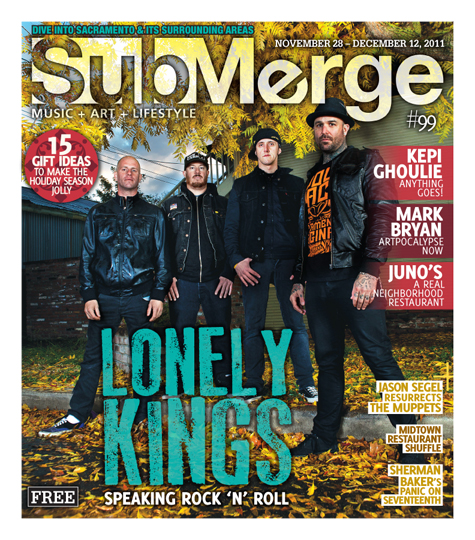
Look for American Heartache to be released sometime early next year. In the meantime, see Lonely Kings headline Ace of Spades on Dec. 23, 2011 at the bands’ sixth annual Rock for Tots, a toy drive for Sacramento Salvation Army. Bring a toy and receive a raffle ticket for prizes from local vendors. Doors open at 6:30 p.m., and the event is all ages.
Local singer-songwriter Sherman Baker recently released his second EP, Panic on Seventeenth, and will celebrate with a show at Luigi’s Fungarden on Friday, Dec. 2, 2011. Fans of Wilco, Violent Femmes and The Pixies are sure to dig Baker’s nasal-y, folk-meets-punk-rock vibe. With your $5 admission to the show, which starts at 8:30 p.m., you’ll get a free download card for Panic on Seventeenth. Accompanying Baker that night will be Joseph Kojima Gray on bass and Brian Guido on drums. Both are also in the band 50-Watt Heavy. Opening the show will be Brolly the Well and Damon & Mason (of the band Forever Goldrush). Baker worked on his new four-song EP with Robert Cheek (producer, engineer) and Matt McCord (played percussion on the recordings); both are longtime staples in the Sacramento music scene. The four songs on Panic… will show up in some form or another on a full-length album Baker plans to record in February 2012 called Seventeenth Street, which will also feature eight brand new songs. Baker plans to spend two weeks at The Hangar, again with Robert Cheek manning the boards. For more information and to keep in the loop with all things Sherman Baker, visit Shermanbakermusic.com


